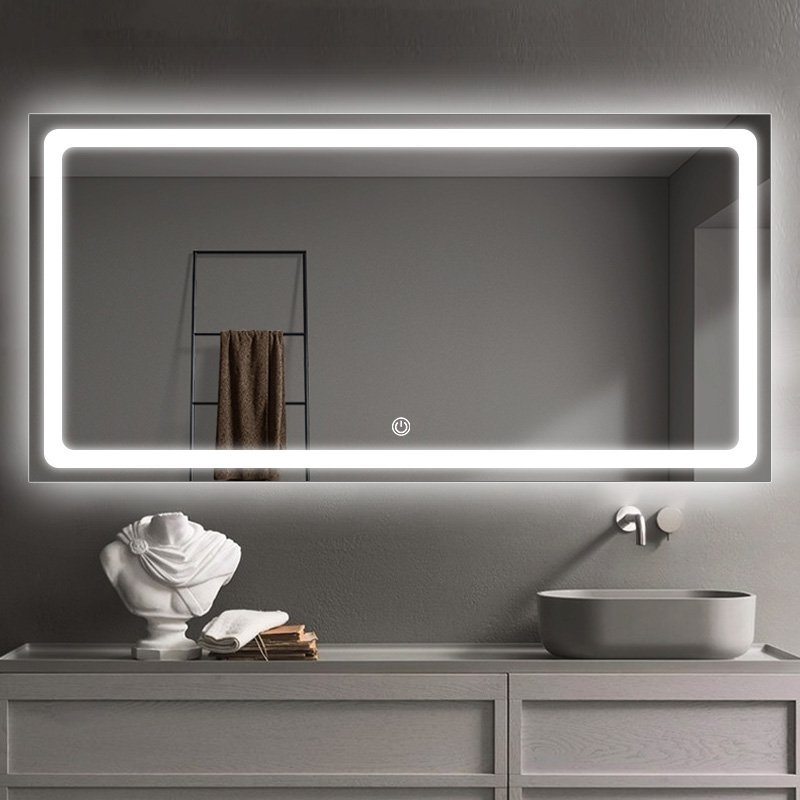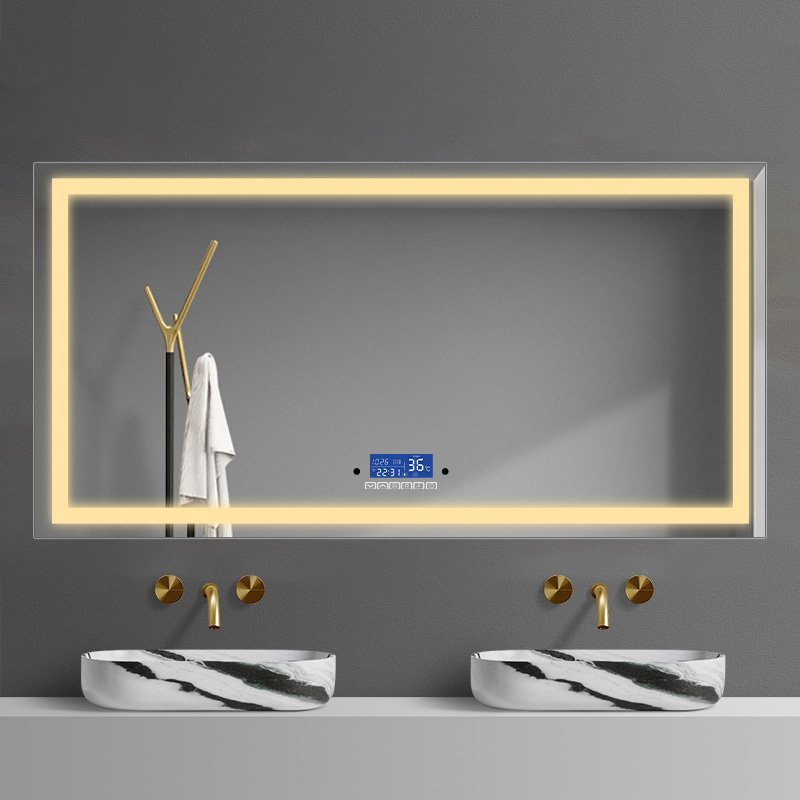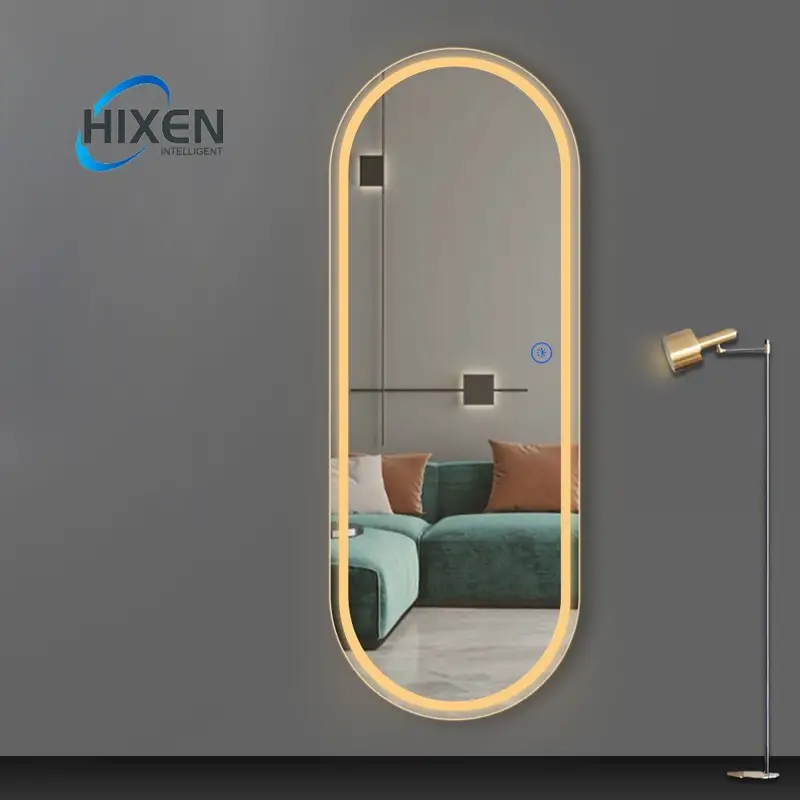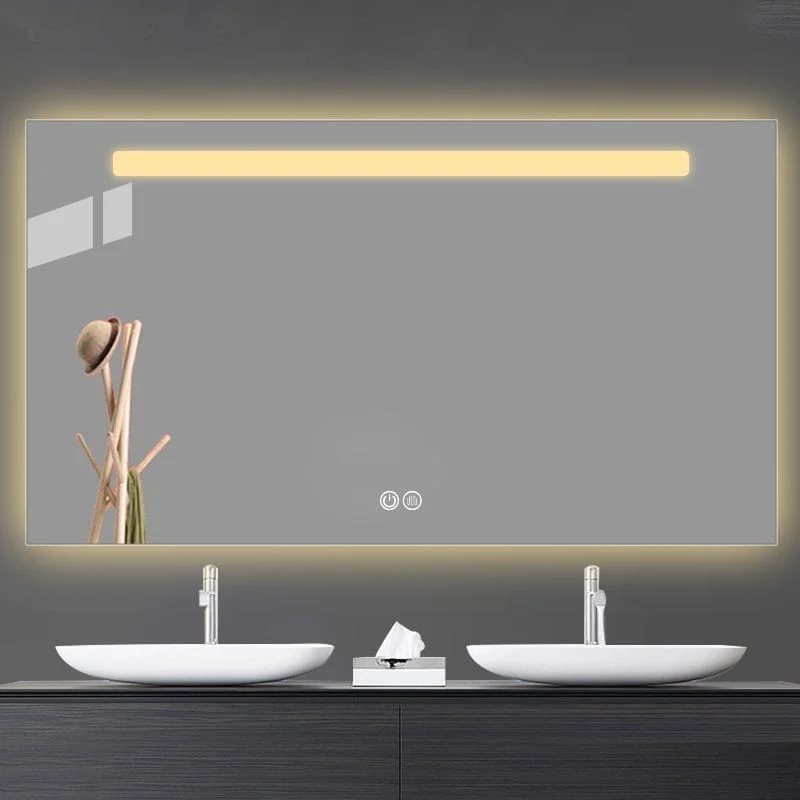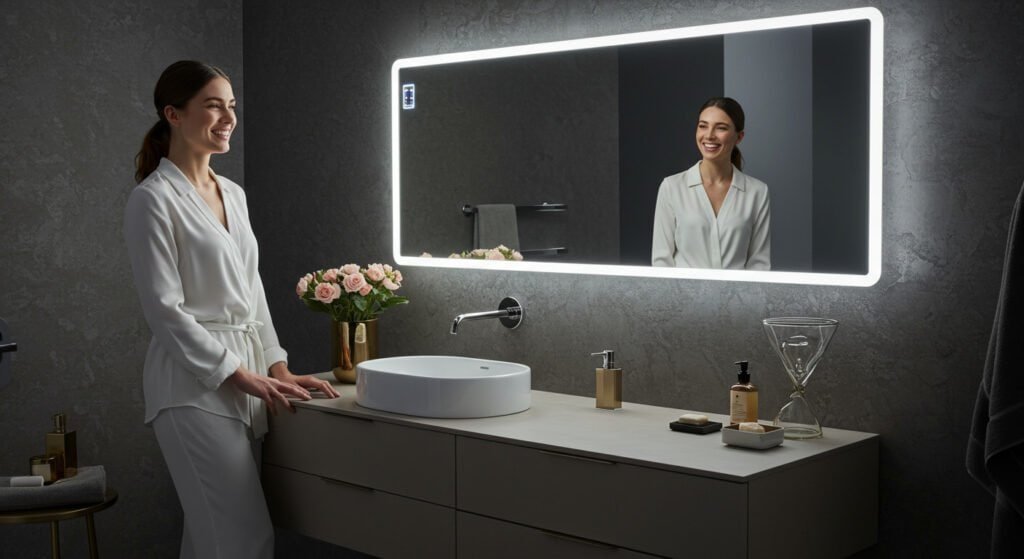|
Getting your Trinity Audio player ready...
|
Choosing the right bathroom mirror size can transform your bathroom space, but if not chosen correctly, it can create a cluttered or unbalanced look. How can you choose the perfect mirror size to enhance your overall bathroom experience?
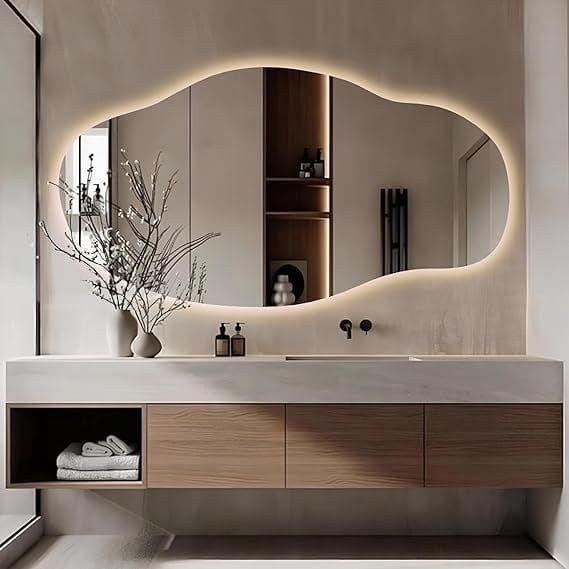
To choose the right bathroom mirror size, consider the width of your vanity, available wall space, and bathroom layout. Select a mirror slightly smaller than the vanity width for proportional balance. Custom and personalised LED mirrors can further optimize the design for unique needs.
Keep reading for in-depth advice and tips on how to choose the perfect bathroom mirror size.
Why Is Choosing the Right Bathroom Mirror Size Important?
Selecting the right mirror size affects not only the look, but also the functionality of your bathroom. The right size can create a balanced, harmonious space, while an ill-fitted mirror can disrupt the entire look.
Ensuring that your mirror fits well within the given space enhances both practical use and the overall visual appeal of the bathroom. This is why many homeowners opt for a custom LED mirror from trusted LED mirror manufacturers to achieve an ideal fit.
A custom or personalized LED mirror can be designed to meet both aesthetic and functional requirements. This way, the mirror’s dimensions, lighting, and any additional features such as backlighting and defogging are perfectly matched to your specific bathroom design.
How to Measure Your Bathroom Space?
The first step in choosing the right mirror size is to measure your bathroom space accurately. Begin by measuring the width of the vanity or sink and the available wall space.
Ensure your measurements are precise by using a tape measure and recording the exact width and height of the available space. Leave at least a few inches between the edge of the mirror and the wall or ceiling.
Measurements will help you avoid a mirror that overwhelms the room or appears too small. Bathroom mirror manufacturers often suggest having the mirror be slightly smaller than the vanity to create a balanced look. If you want advanced options, a personalized LED mirror with adjustable sizing is a great solution.
What Is the Rule for Mirror Size?
The general rule is that a bathroom mirror should not be wider than the vanity or sink. Ideally, it should be about 2-4 inches narrower to maintain balance.
A mirror wider than the vanity may look disproportionate, while a smaller one can appear insufficient. Aim for a mirror that matches approximately 70-80% of the vanity width.
This rule ensures the mirror doesn’t overpower the vanity but allows enough space to groom. Lighted mirrors with custom sizes, offered by LED mirror wholesalers, make it easier to stick to this rule while adding elegance and functionality.

Is It Better to Have a Big or Small Mirror in the Bathroom?
Deciding on a big or small mirror depends on your bathroom size and layout. Larger mirrors can make a space look bigger, while smaller mirrors are perfect for compact or minimalist bathrooms.
A larger mirror can reflect more light and make the room appear bigger, especially if it is a backlit mirror. Smaller mirrors work well for focused use in compact spaces.
If you’re not sure, talk to an LED mirror supplier or find lighted mirror manufacturers who offer custom options. The right mirror size should meet your functional needs and add to the beauty of your space.
Should a Bathroom Mirror Be as Wide as the Sink?
Matching the width of the mirror to the sink creates a cohesive look. However, the mirror can be slightly smaller or larger depending on your preference and space constraints.
A mirror that matches the sink width provides a balanced appearance, making the bathroom look tidy and well-organized. However, custom LED mirrors allow for more personalized adjustments.
Customisation options provided by an LED mirror factory enable you to choose mirrors that perfectly align with your specific sink or vanity size. This option is ideal for homeowners looking for tailored solutions.
What Size Mirror for a 30-Inch Bathroom Vanity?
A common guideline is to choose a mirror that is about 24-28 inches wide for a 30-inch vanity. This creates a balanced look without overwhelming the space.
For a 30-inch vanity, a mirror width between 24-28 inches is usually ideal. This size range ensures a proportional fit while allowing enough space for wall-mounted light fixtures if needed.
Personalised LED mirrors can be adjusted to match this size perfectly, ensuring that even smaller vanities look stylish and functional. Consult bathroom mirror manufacturers for options that fit your design and budget.

What Is the Rule 2 of a Mirror?
The “Rule 2” involves ensuring the mirror is placed at eye level. This enhances usability and comfort during daily routines.
Snippets Paragraph: The Rule 2 states that the mirror’s center should align with the average user’s eye level, ensuring easy visibility for everyone using the bathroom.
Placing the mirror at eye level, often around 60 inches from the floor to the center, maximizes its usability. LED mirror manufacturers often design their products with this rule in mind, making installation straightforward.
What Is the Current Trend in Bathroom Mirrors?
Modern trends in bathroom mirrors focus on sleek, frameless designs, integrated lighting, and multifunctionality. Backlit mirrors and lighted mirrors are particularly popular.
Current trends include frameless, backlit mirrors and smart mirrors that offer features like defogging, time display, and Bluetooth connectivity.
The demand for integrated technology has made lighted mirror manufacturers more popular. These mirrors enhance the ambiance and functionality of bathrooms. Custom LED mirrors are increasingly sought after for their flexibility in size and features.
What Is the Most Popular Shape for a Bathroom Mirror?
Round and rectangular mirrors remain the most popular choices. The choice often depends on the overall design and layout of the bathroom.
Rectangular mirrors offer a classic look that fits well with various styles, while round mirrors add a softer, modern touch.
The decision often comes down to personal preference. A personalised LED mirror can be customized in any shape to suit your taste and space. Consult with a reliable LED mirror factory for bespoke solutions.

How Big of a Mirror for a 72-Inch Vanity?
For a 72-inch vanity, a mirror between 64-68 inches wide is usually best. This ensures a proportionate and elegant look.
Choose a mirror that is slightly narrower than the vanity, ideally by 4-8 inches. This maintains balance and allows space for lighting fixtures if needed.
Large, backlit mirrors work well with wider vanities, as they reflect more light and enhance the bathroom’s spaciousness. LED mirror suppliers can provide custom options tailored to these dimensions.
How Big of a Mirror for a 36-Inch Vanity?
A 28-34 inch wide mirror is generally suitable for a 36-inch vanity. This allows for enough space without looking disproportionate.
For a 36-inch vanity, choose a mirror width between 28-34 inches. This ensures a balanced, visually appealing setup.
Consulting with bathroom mirror manufacturers or a lighted mirror manufacturer can provide you with tailored solutions. Personalised LED mirrors can be crafted to fit these specifications perfectly.
Should a Bathroom Mirror Be Above the Faucet?
Ideally, a bathroom mirror should be positioned above the faucet for optimal use. This placement helps users comfortably access the mirror without obstruction.
Installing the mirror above the faucet aligns with practical usage and ergonomic considerations, ensuring easy access.
The placement should also consider lighting. A backlit mirror installed above the faucet provides enhanced visibility. For bespoke designs, reach out to an LED mirror wholesaler.
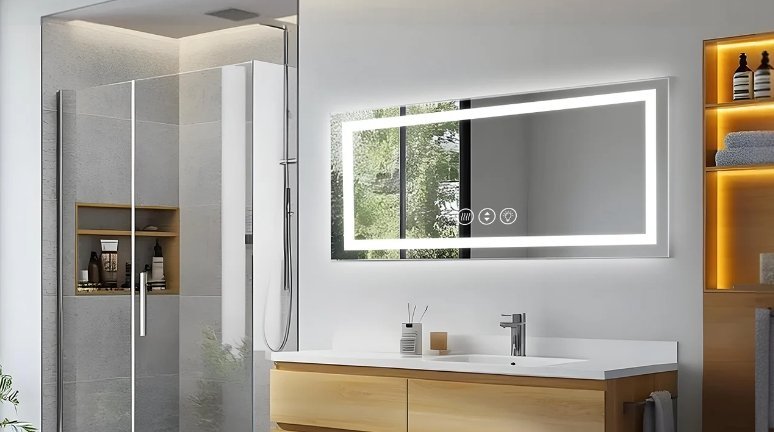
What Type of Mirror Makes a Bathroom Look Bigger?
Backlit mirrors and large, frameless mirrors can create an illusion of more space. They reflect more light, making the room feel brighter and larger.
Large backlit mirrors expand the visual space by enhancing light distribution. This effect makes even small bathrooms look more spacious.
Choosing a backlit or lighted mirror from an LED mirror factory can optimize space while adding modern elegance. Custom LED mirrors are particularly effective at this.
How to Choose Vanity Mirror Size?
Choosing the right vanity mirror size involves balancing proportion, functionality, and aesthetics. Ensure that the mirror complements the vanity’s size.
Select a mirror slightly narrower than the vanity for an ideal proportion. Custom LED mirrors can be tailored to any size for perfect fitting.
Consult with LED mirror manufacturers for custom options. Personalised LED mirrors allow you to select a design that fits your space without compromising functionality.
How to Pick Out a Bathroom Mirror?
Consider the size, shape, and features such as backlighting and anti-fog capabilities. The mirror should complement the overall bathroom style.
Evaluate factors like mirror size, shape, and special features. Custom and lighted mirrors enhance both aesthetics and usability.
Talk to an LED mirror supplier to explore options such as custom lighting and Bluetooth integration. A personalised LED mirror offers functionality tailored to your needs.
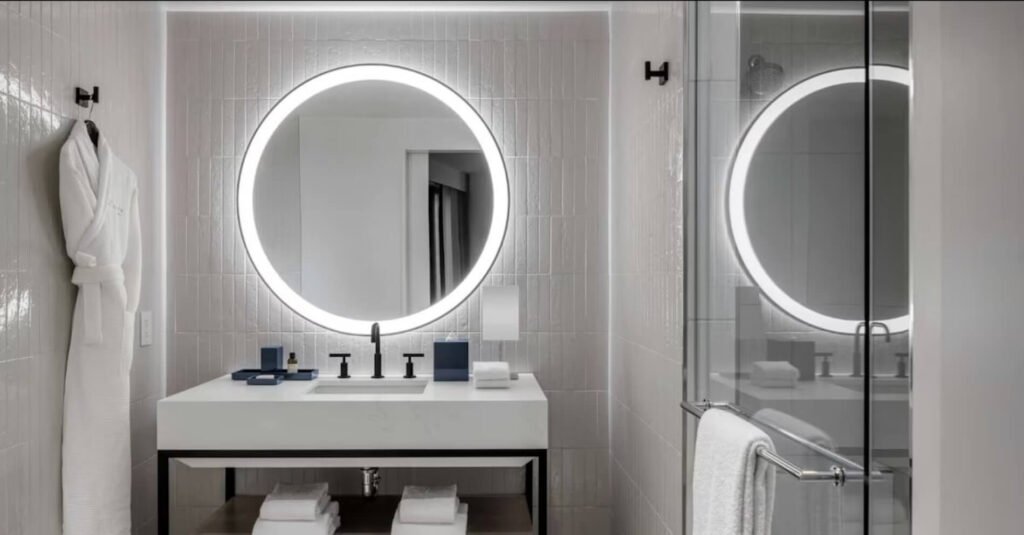
Should a Bathroom Mirror Be Rectangle or Circle?
Both rectangular and circular mirrors have their unique benefits. The choice depends on personal preference and the bathroom’s design.
Rectangular mirrors offer a classic, structured look, while circular mirrors provide a softer, modern aesthetic. Choose based on your bathroom style.
For a balanced look, rectangular mirrors work well with most vanities. Circle mirrors, however, are trending for their unique style. Lighted mirror manufacturers offer both shapes with customizable options.
Conclusion
Choosing the right bathroom mirror size involves multiple factors, including vanity width, available wall space, and design preferences. Consult with an LED mirror manufacturer or LED mirror supplier for custom and personalised LED mirror options that fit your space and needs. If you wanna know more about bathroom mirror, contact us!






